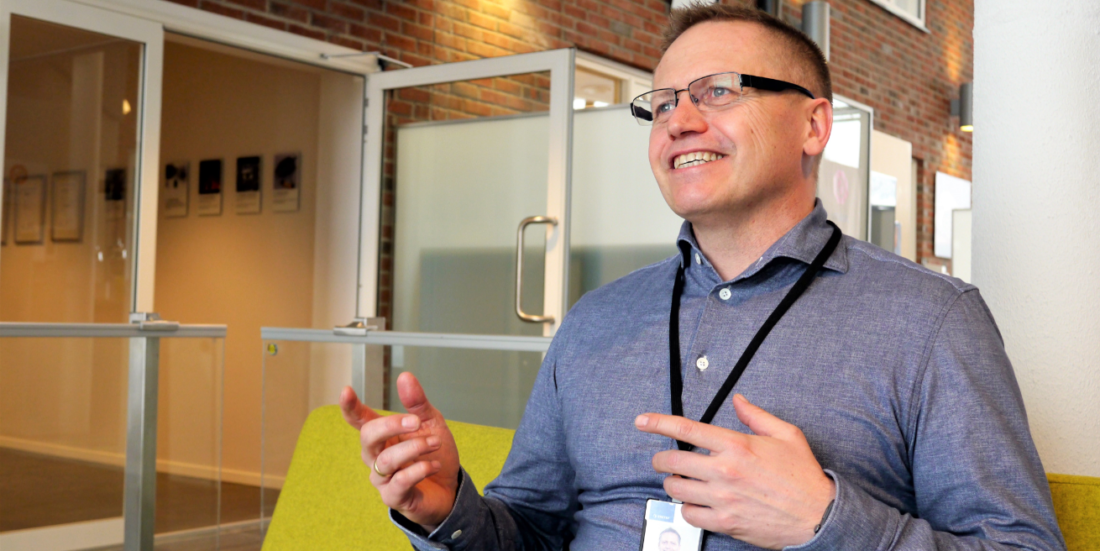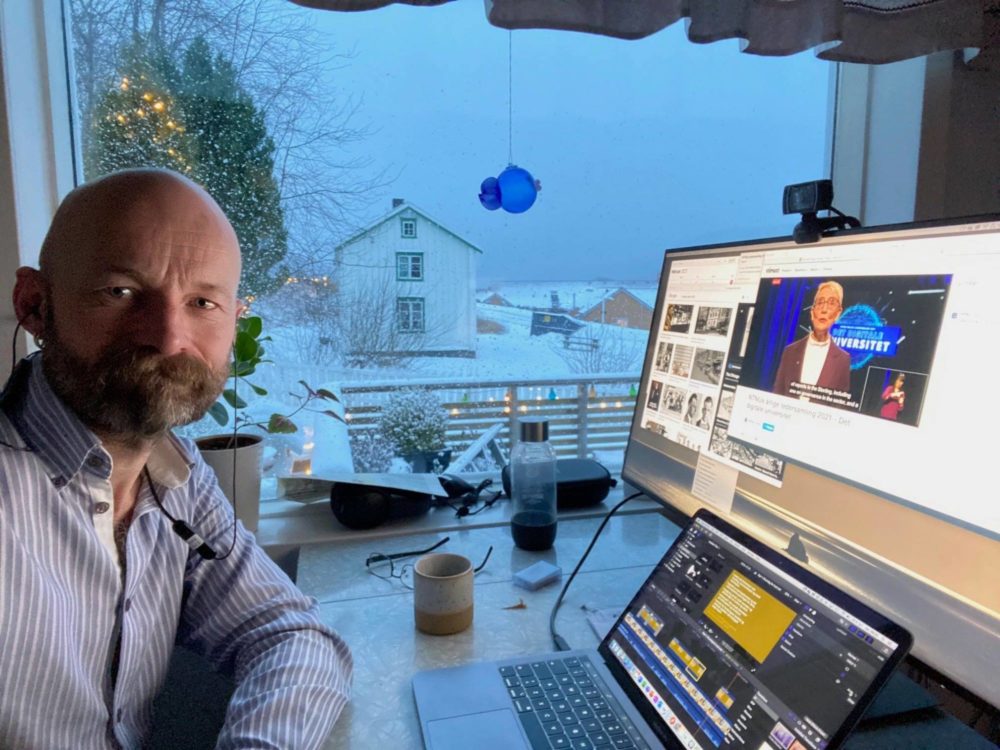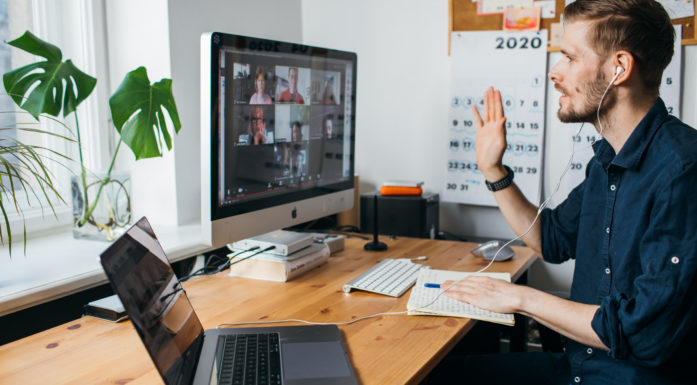Working from home is here to stay – and is transforming the roles of managers
The Covid-19 pandemic has forced companies to change the way they organise their day-to-day activities. Many people find working from home no problem at all. According to researchers, there is little to suggest that these changes will be reversed once the pandemic is over.
This is the opinion of Nils Brede Moe, a Chief Scientist at SINTEF, Norway.
He is heading a team of researchers who throughout 2020 – ‘the year of working from home’ – has been studying the dynamics both within teams and between managers and employees in five major Norwegian companies.
His team has carried out both in-depth interviews and quantitative surveys and is now hard at work to complete a number of scientific articles for leading journals.
“One of our key findings is that managers who can relax their need to control their subordinates and make themselves superfluous by practising so-called ‘serving leadership’ are the ones who have tackled the challenges of the last year best”, he explains. “At the opposite end of the scale, there are those who focus on formal processes and maintaining control, and this group have had things much tougher”, says Moe.
“Nor does working from home result in lower levels of individual productivity. “In fact, the opposite is frequently the case”, he adds.
Pandemic offers researchers greater insights
Moe believes that this last year, when working from home has been either mandatory or highly recommended, has been a test of how effectively companies and organisations are structured.
“We’ve been conducting research into teamwork and interpersonal relations in the workplace for many years, and the pandemic has offered us a unique opportunity to look into how companies adapt to sudden changes in their day-to-day situations.
Trust-based leadership is best
Before Christmas, the Norwegian Union of Municipal and General Employees (Fagforbundet) carried out a survey of 655 managers employed in its member companies and asked them what style of leadership they emphasised most during the pandemic.
As many as 84 percent responded that trust-based and motivational leadership was most important, followed by structure-based leadership (with 74 percent). Controlling leadership came out bottom of the list. Only five percent said that this type of leadership was the most important.
The results of the survey carried out by the union thus support research that SINTEF had already completed.
“Why is this the case?”
“The situation is complicated”, says Moe. “An important reason is probably that Norwegian workplace dynamics are much more egalitarian. We favour flatter hierarchies and aspire after equality to a much greater extent than in other countries. The high levels of trust that exist between managers and employees mean that the transition to the extensive use of working from home during the last twelve months has gone relatively smoothly and without any major problems”, he says.
“In Norwegian knowledge companies, there is nothing new about the idea of working from home or working from anywhere”, he continues. “Many factors indicate that our experiences during the pandemic will accelerate the development of so-called ‘hybrid’ working models in the future”, says Moe.
“Does this mean that there’ll never be a return to ‘normal’?
“I think it’s very unlikely”, he says. “There are clear beneficial outcomes of working from home during certain periods – the results of increased levels of employee flexibility. In conversations that we’ve had with many major Norwegian companies, a clear trend is emerging – the hybrid model is here to stay”, says Moe.
The shift to a hybrid model will be more disruptive than the move to all-remote work.
It’s not easy being a new recruit working from home…
This is the opinion of Aksel Tjora, who is a Professor at the Department of Sociology and Political Science at NTNU.
“It’s difficult to predict how day-to-day life in Norwegian organisations will turn out when things start to return to normal”, says Tjora. “But no-one can doubt that our experiences from the pandemic will dominate the discussion”, he says. Since the start of this year, Tjora has been working from home in the rural atmosphere of Råkvåg in Indre Fosen, about 70 kilometres north of Trondheim.
He has joined ten other people to form the ‘Sjøgata Arbeidslag’ – a small community of remote workers gathered together on the old quayside by the fjord.
“I’m no less productive working here”, says Tjora, who describes himself as a digital nomad.
“However, the hybrid workplace model has its shortcomings, especially for new employees, who experience a much tougher induction into organisations that demand extensive amounts of remote working”, he says.
Nils Brede Moe at SINTEF agrees.
“Extensive and effective networks boost productivity in any company, and our research indicates that personal relationships are best established when people meet face-to-face”, he says. “Our studies demonstrate that employees who already had established networks before they started working from home, benefited greatly from them during the pandemic and performed their assignments much better as a result”, says Moe.
- Read also: New job in the time of corona?
…but fewer time thieves are an advantage
Moe is quick to point out the purely practical benefits of the hybrid workplace model, such as increased employee flexibility, fewer interruptions, less noise and commuting.
“Our interviews reveal that people can concentrate more when working with complex assignments”, he says. “Most of us have experienced being interrupted by others while we’re trying to work, and this can be irritating. It might take as much as 10 to 20 minutes before we can return to our working state after such interruptions”, says Moe.
“What about time thieves?”
“Yes, they distract our focus”, he says. “However, it’s also important to be aware that what suits a single individual may not necessarily be optimal for the team or the organisation as a whole”.
To illustrate his point, Moe uses a sporting metaphor.
“In team sports, we judge success based not only on a player’s performance, but also on his or her contribution to the team. Team members who only try their hardest for their own benefit may damage the productivity of the team as a whole. The key lies in finding the balance between optimising individual, team and organisational productivity, and to be aware of possible necessary compromises”, says Moe.
- Read more on the study: Work Patterns of Software Engineers in the Forced Working-From-Home Mode
This is what some Norwegian companies say about their experiences of a year of working from home:
Zedge is one of the companies that has been working with the research team from SINTEF Digital. Employees miss the informal aspects of being in the office:
For most of the time since March 2020, the 20 or more employees at the Trondheim-based media and technology company have been working from home. For prolonged periods, when infection levels were at their height, there were hardly any employees at all working in the company’s offices.
On the move
“For the most part, things have gone pretty well, and this is mostly because we had well-established remote working procedures in place before the pandemic took hold”, explains General Manager Vemund Lindås, sitting between piles of cardboard boxes and rolls of bubble wrap.
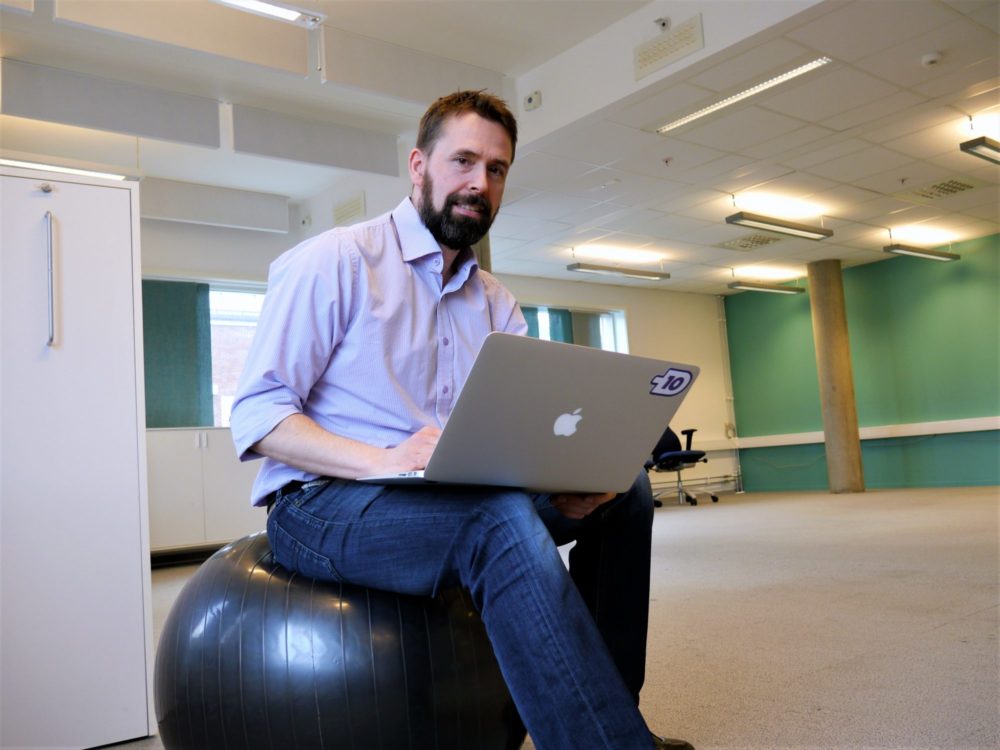
New experiences. During the last year, the media and technology company Zedge has had an extensive working from home policy in place for all its 20 employees. “We’ve seen both benefits and shortcomings”, says General Manager Vemund Lindås. Photo by Jan Are Hansen.
Zedge is a listed company in the process of moving from the Miljøbygget in Teknobyen in Trondheim, to offices in the new MAX building in Tempevegen. The company also has branch offices in Lithuania and the USA.
In spite of a turbulent year, Zedge has succeeded in delivering growth and some very positive results.
“There are many factors contributing to this, but our total productivity has not declined in spite of our employees working mostly from home”, says Lindås. Quite the opposite, in fact”, he says.
Less creative
In fact, in 2020, the company managed to add five new recruits to its staff in Trondheim. One of the main challenges has been to ensure that the new employees experience as smooth an induction as possible into the company’s working culture. This is in line with the results of the surveys carried out by SINTEF, which indicate that the combination of new employees working from home can generate problems.
“One example involved one of our project teams where two of the team members were new employees at Zedge”, says Lindås. “It was right in the middle of a period when almost everyone was working from home, and we found that for the team to operate effectively, it was essential that they were allowed to meet face to face on a regular basis”, he says.
You may perhaps have heard of the hackathon phenomenon? In brief, a hackathon is an informal way of generating new ideas by which teams work together in order to find solutions to a range of different problems – all carried out in a very relaxed setting with beer and good food.
“Hackathons are virtually a tradition here at Zedge”, says Lindås. “But we found that the social aspect didn’t really transfer very well to a digital format. “The process itself went very well, with good results in terms of productivity, but we all missed the informal and creative atmosphere”, he says.
“Was it a valuable exercise?”
“Absolutely”, he adds.
No focus on control
Lindås emphasises that the company has learned a great deal during the pandemic. The hybrid workplace model is working, although many employees report that they miss being with their colleagues at the office.
“They want ‘office first’ as soon as this becomes possible”, says Lindås. “We already had a policy of flexible working from home when necessary, and we intend to continue with this. In contrast, our branch office in Vilnius in Lithuania has established a ‘remote first’ policy and will continue to offer this as an employee benefit when things start to return to normal after the pandemic”, he says.
“As a manager, do you miss having control over your employees?
Lindås smiles broadly.
“No”, he says. “Micromanagement and obsession with detail don’t work well in a knowledge company like Zedge. In my opinion, it’s a poor approach to management, regardless of the sector you’re working in. I’m more worried about our employees becoming overworked”, says Lindås.
“Do hybrid workplace models blur the distinction between work and free time?”
“This hasn’t been a problem for us, but if working life is starting to encroach on people’s free time, then managers like me will definitely have to bear this in mind”, he concludes.
It’s Friday lunchtime in the canteen at the technology company Kantega. Normally, lunchtime is the social highlight of the day for the company’s 75 employees, but the pandemic has brought all that to a grinding halt. And the boss misses her hugs:
Camilla Wadseth, who is General Manager at Kantega’s Trondheim office, looks out across a sea of empty tables and chairs.
“I’m the kind of manager who enjoys an informal chat”, she says. “Especially over a snack and a cup of coffee. Innovation and new solutions – our great ideas – are generated just as much here as they are in our meeting rooms. I have to admit that I miss all that, as well as all the hugs”, she smiles.
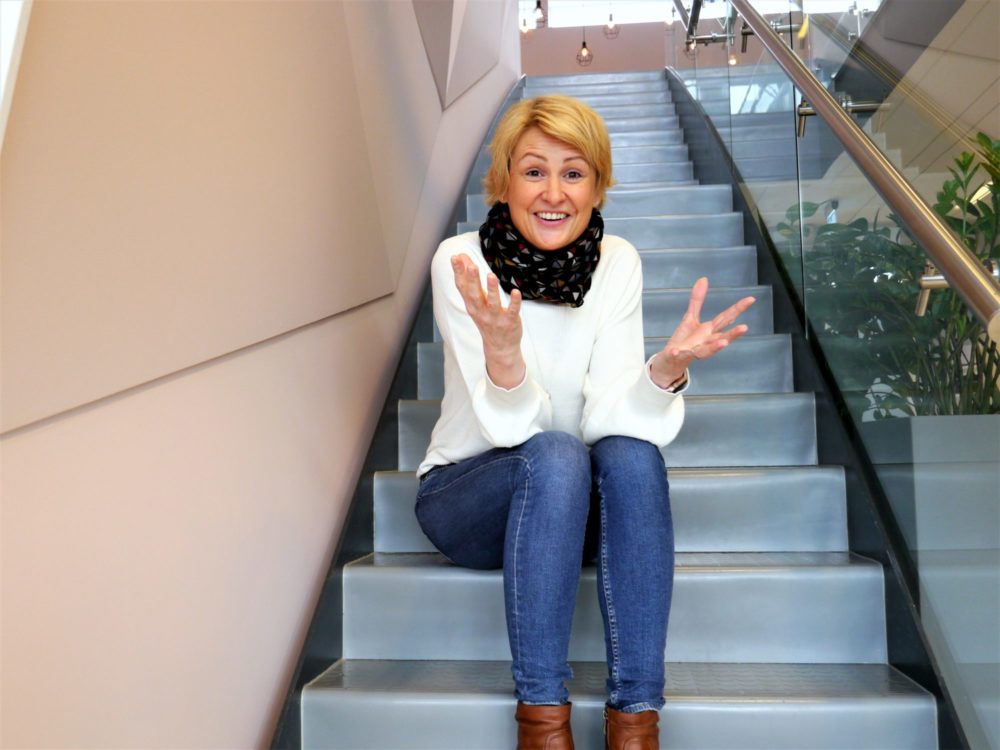
Alone on the stairs. Camilla Wadseth is General Manager at technology company Kantega’s Trondheim office. There’s hardly anyone working in the office these days. She looks forward to the time when it will be bustling with people again. Photo by Jan Are Hansen
Well prepared
Even though the pandemic has meant that almost all of its employees have had to work from home, Kantega is well equipped to adapt to different ways of working.
“As an IT company, we’re no stranger to hybrid models and remote working, and have been practising these for some time now”, explains Wadseth. “We’ve already put such systems and procedures in place, and they work very well. In terms of productivity, we’re delivering the same levels as we did before the pandemic took hold”, she says.
With more than 80 employees in the Trondheim office alone, it’s no surprise that people experience things differently.
“We have our introverts who think that working from home is a wonderful idea, and we have those who are more extrovert who would rather spend as much of their time as possible in the office. There’s a wide range of opinion”, says Wadseth.
“Is this causing problems?
“No, I wouldn’t say that”, she says. “The projects we carry out for our clients are almost always conducted in teams. This requires collaboration and an ability to adapt regardless of whether we’re working digitally or face-to-face”, says Wadseth.
Sharing the same challenges
A factor peculiar to Kantega is that since its launch in 2003, the company has been wholly owned by its employees.
“Has this ownership structure had any influence on your response to the events of the last year?
“Yes, definitely”, says Wadseth. “The ownership structure means that when things get tough, everyone takes responsibility, makes their contributions and pulls in the same direction. Our feeling is that we share the same challenges to a much greater extent than in companies that are more ‘top-down’ and hierarchical. Anyway, that’s the way we see things here”, explains Wadseth.
She does not believe that things will be the same when wider society starts getting back to normal.
“There will be changes, but it’s impossible to predict how things will look in the future”, says Wadseth, who also describes the last year as a learning experience.
“It has provided us with unique knowledge and valuable experience from which we will learn lessons for the future. Working together with SINTEF has also been very stimulating, she says.
Everyone was caught by surprise at the bank Sparebank 1 Midt-Norge (SMN), even though a contingency plan for working at home had been put in place:
“We had excellent contingency plans in place for how we should tackle a situation requiring us to have all our employees work from home, but that a viral pandemic could trigger such a contingency took us all by surprise”, says Johan-Petter Winsnes, who is the bank’s HR Manager.
At the end of March 2021, about 75 percent of the bank’s 650 personnel employed at the bank’s main office in Søndre gate in Trondheim are working from home.
“At times it’s all been very challenging, but the entire organisation has coped with the new situation very well”, he adds.
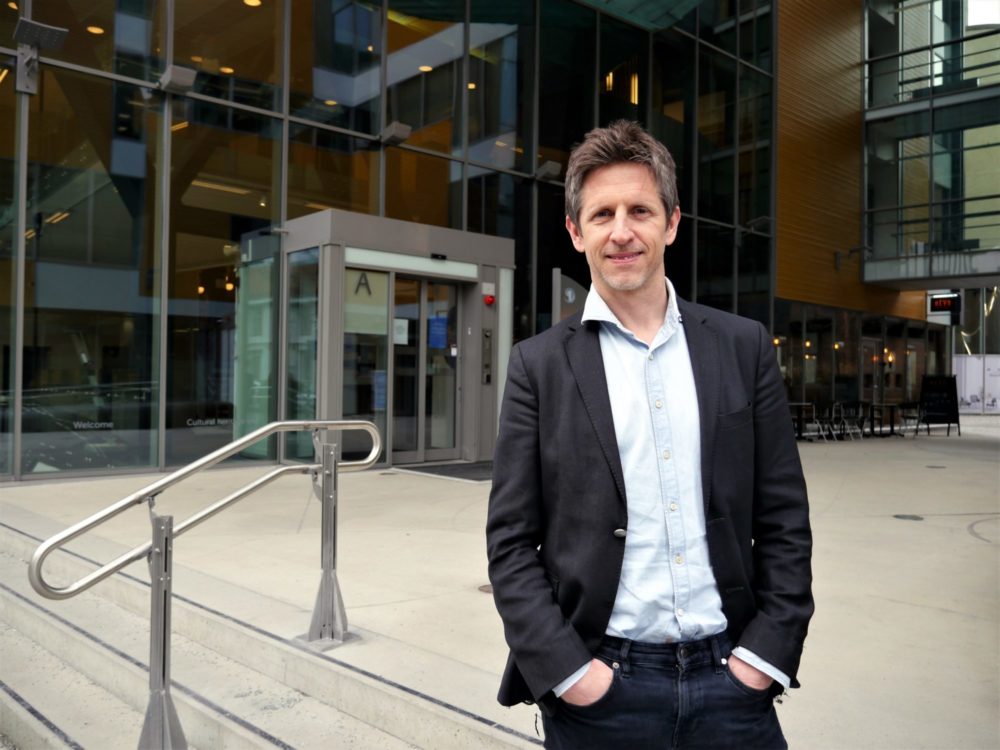
75 percent working from home. “There’s an enormous difference between being directed to work from home for months on end, and to have the option to do so just on the days when you feel like it”, says Johan-Petter Winsnes, HR Manager at SpareBank 1 Midt-Norge. Photo by Jan Are Hansen
Worried about wear and tear on employees
The bank had assembled a crisis team as early as ten days before the lockdown was imposed in Norway in March last year and, as was the case in the rest of the business community, its members knew next to nothing about the massive effect that the pandemic was going to have.
Winsnes makes no secret of the fact that he is worried about wear and tear on the bank’s employees.
“We’ve adhered to all the national and local municipal guidelines and directives”, he says. “These are essential. However, I’m aware from the conversations I’ve had that many people desperately miss being in the office. They miss the ambience, informal discussions and face-to-face interactions. We cannot be fully aware of the great importance of the psychosocial value of the workplace until it is taken away from us”, says Winsnes.
He points out that most employees at the bank have had the opportunity to work from home at various periods in the past.
“But there’s an enormous difference between being directed to work from home for months on end, and to have the option to do so just on the days when you feel like it”, he says.
“Is this really an important distinction?
“It’s crucial”, says Winsnes.
‘One SMN’
The most difficult challenge that the bank has had to face during the pandemic has been the maintenance of its operations and societally critical tasks. Teams that have assumed responsibility for these tasks have been granted exemptions from many of the restrictions.
“We’ve also succeeded in maintaining good relations with our clients, both in the private and public sector markets”, says Winsnes.
Just as the pandemic was taking hold, the bank was entirely preoccupied with a project called ‘One SMN’. This is a group-wide initiative intended to consolidate in-house synergies between our business areas and constituent companies.
“Simply getting all our departments, teams and groups to work effectively together on such a project is a complex task”, says Winsnes. “And this wasn’t exactly made any easier with all our employees working from their various homes, not to mention all the restrictions and limitations that followed the waves of infection. I still believe that we will successfully bring the project home”, he concludes.
- More information about the study: Work Patterns of Software Engineers in the Forced Working-From-Home Mode
